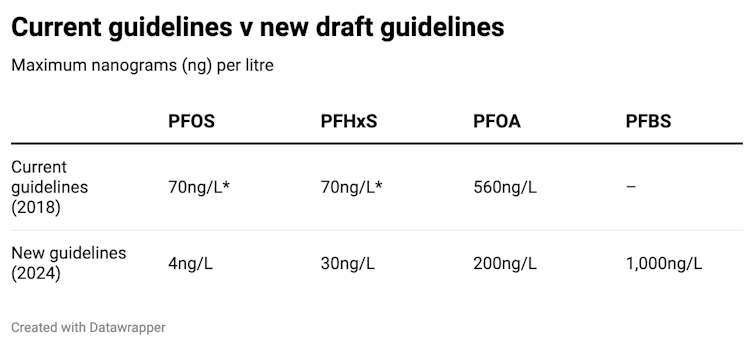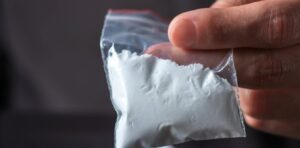Draft guidelines for ‘forever chemicals’ have been released. Here’s what it means for drinking water safety in Australia

The Australian National Health and Medical research Council (NHMRC) has today released draft guidelines for acceptable levels of per- and polyfluoroalkyl substances, or PFAS, in drinking water.
PFAS chemicals are also known as “forever chemicals”, because they don’t break down easily and can persist in the environment, including drinking water supplies.
The new guidelines – which are not mandatory but will inform state and territory policy – are expected to be finalised in April 2025. They propose a reduction in the maximum levels previously considered safe for four key PFAS chemicals: PFOS, PFOA, PFHxS and PFBS.
Continually scrutinising and updating our PFAS regulations is important to ensure Australians’ safety. However, these updated guidelines are unlikely to have a significant impact on Australia’s drinking water. The majority of potable water supplies in Australia either have no detectable PFAS, or have levels already below the new limits.
What are PFAS chemicals?
PFAS are highly fat-soluble compounds that are very slow to break down. They are basically long chains of carbon atoms studded with fluorine molecules.
PFAS chemicals are inert, water-repellent and heat-resistant. These properties make them ideal for industrial usage and they have been used in firefighting foams and fire-retardant material. They have also been used in common household items such as nonstick pans and stain-resistant fabrics.
PFAS chemicals are very slow to break down.
Gorodenkoff/Shutterstock
Unfortunately, their useful industrial stability means they persist in the environment and can accumulate in the human body. It can take five years for half an ingested dose of PFAS to be removed.
Given PFAS chemicals have the potential to mimic the body’s own fats, there has been concern they could harm our health if sufficient amounts accumulated in the body.
What sorts of health effects are they linked to?
The buildup of a chemical that’s hard to remove from our bodies is always of concern. Despite this, the potential health risks appear to be low. In 2018 the Australian Expert Health Panel for PFAS looked in detail at the evidence.
One of the largest concerns was PFAS chemicals’ ability to increase levels of cholesterol in the blood, potentially increasing heart disease risk. However, studies of people who have been chronically exposed to significant levels of PFOA have not shown statistically significant increases in heart disease.
In 2018, the report from Australia’s expert health panel stated:
Evidence to date does not establish whether PFAS at exposure levels seen in Australia might increase risks of cardiovascular disease… Established risk factors … are likely to be of a much greater magnitude than those potentially caused by PFAS.
Cancer has also been a concern. However the expert panel found no consistent evidence that PFAS chemicals are associated with cancer. One study even found exposure to PFOA decreased the incidence of bowel cancer.
However, the impact of PFAS on human health is continuously reviewed as new evidence comes to light.
Why has Australia revised its drinking water guidelines?
Australia began to phase out PFAS chemicals in the early 2000s. Since then, the levels of PFAS detected in the Australian population have steadily dropped.
Now that industrial use is being phased out, the main way we are exposed to PFAS is through things like persistent environmental contamination. While drinking water is not a major source of PFAS, water can be contaminated from environmental sources, for example, if contaminated dust or ground water makes its way into reservoirs.

Most drinking water levels in Australia either have no detectable PFAS or are already below the new levels.
Juergen_Wallstabe/Shutterstock
The Australian Drinking Water Guidelines provide limits for how much PFAS is allowed to be in our drinking water.
The NHMRC periodically reviews the health evidence around PFAS used to develop these guidelines, which were last updated in 2018. The latest review looks at additional evidence available since then.
A few developments were of particular interest in this review: studies about the influence of PFAS on thyroid function. Altering thyroid function can be problematic because thyroid hormones regulate our metabolism, growth and development.
The International Agency for Cancer Research’s (IARC) recent ruling on PFAS and cancer also needed to be investigated. The IARC has classified PFOS – one of the four key chemicals Australia is regulating – as “possibly carcinogenic to humans”. However the IARC noted there was “inadequate” evidence PFOS directly causes any type of cancer in people.
This agency can rule on the probability that a chemical can cause cancer under any possible exposure, no matter how extreme. But it doesn’t evaluate the risk of cancer from ordinary exposure.
This means the NHMRC needed to reevaluate the evidence that the levels present in drinking water would constitute a risk.
What are the new PFAS limits?
The NHRMC considered evidence about PFAS exposure in animal studies, and by looking at human epidemiology.
In studies involving animals, the NHMRC review paid particular attention to what concentration of PFAS exposure had no effect on their health. This threshold is used to determine limits for humans, by adding a safety buffer usually a hundred times lower than the level that was safe for animals.
The limits are set are carefully considering the evidence about impact on human health, as well as evaluating how much PFAS exposure is likely from sources beyond drinking water, such as food and inhaled dust.
The proposed limits are:

Note: PFOS and PFHxS are now regulated separately.
NHMRC
These guidelines are unlikely to have a significant impact on health. As the NHMRC report shows, majority of potable water supplies in Australia have no detectable PFAS, or levels are already below these new limits.
For example, drinking water sampling for WaterNSW found PFOS levels were between 1.2ng/L and undectable. Similar results were found for PFHxS (between 1.4 and 0.1ng/L) and PFOA (basically undetectable).
While the concentration of PFAS in bores near contamination sites are higher, these are typically not used as sources of drinking water.
The Australian guidelines differ from some international guidelines. The draft guidelines note that different jurisdictions place different weighting on animal and human evidence, and this will affect these regulatory levels.
The draft guidelines are now open to public consultation, with submissions closing on November 22 2024. Final guidelines are expected to be released in April 2025.






